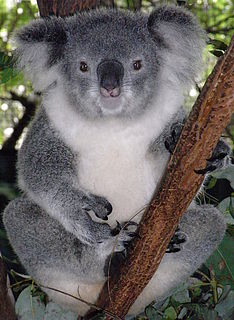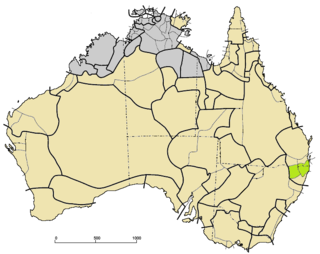Yugambeh, also known as Tweed-Albert Bandjalang, is an Australian Aboriginal language spoken by the Yugambeh living in South-East Queensland between and within the Logan River basin and the Tweed River basin, bounded to the east by the Pacific Ocean and in the west by the Teviot Ranges and Teviot Brook basin.

The Dharug language, also written Darug and Dharuk and also known as Eora (Iyora) or the Sydney language, is an Australian Aboriginal language of the Yuin–Kuric group that was traditionally spoken in the region of Sydney, New South Wales. It is the traditional language of the Darug. The Darug population has greatly diminished since the onset of colonisation.

The history of the Gold Coast in Queensland, Australia began in prehistoric times with archaeological evidence revealing occupation of the district by Australian Aborigines for at least 23,000 years. The first early European colonizers began arriving in the late 1700s, settlement soon followed throughout the 19th century, and by 1959 the town was proclaimed a city. Today, the Gold Coast is one of the fastest growing cities in Australia.

Yugambeh–Bundjalung, also known as Bandjalangic, is a branch of the Pama–Nyungan language family, that is spoken in north-eastern New South Wales and South-East Queensland.
The Gidabal, also known as Kitabal and Githabul, are an indigenous Australian tribe of southern Queensland, who inhabited an area in south-east Queensland and north-east New South Wales, now within the Southern Downs, Tenterfield and Kyogle Local Government regions.
Githabul, also known as Galibal, Dinggabal, and Condamine – Upper Clarence Bandjalang, is an Australian Aboriginal language spoken by the Githabul living in South Queensland and North-East New South Wales.
Lenakel, or West Tanna, is a dialect chain spoken on the western coast of Tanna Island in Vanuatu.

Lower Beechmont is a locality in the City of Gold Coast, Queensland, Australia. It is situated in the Gold Coast hinterland. In the 2016 census, Lower Beechmont had a population of 1,046 people.

The Yugambeh are an Aboriginal Australian people of south-east Queensland and the Northern Rivers of New South Wales, their territory lies between the Logan and Tweed rivers. They are alternatively known as the Minyungbal. A term for an Aboriginal of the Yugambeh tribe is Mibunn, which is derived from the word for the Wedge-tailed Eagle. Historically, some anthropologists have erroneously referred to them as the Chepara, the term for a first-degree initiate. Archaeological evidence indicates Aboriginal people have occupied the area for tens of thousands of years. By the time European colonisation began, the Yugambeh had a complex network of groups, and kinship. The Yugambeh territory is subdivided among clan groups with each occupying a designated locality, each clan having certain rights and responsibilities in relation to their respective areas.
The Kombumerri clan are one of nine distinct named clan estate groups of the Yugambeh people and the name refers to the Indigenous people of the Nerang area on the Gold Coast, Queensland. Australia
The Kugu Nganhcara, also Wikngenchera, Wik-Ngandjara (Ngandjara) are an Australian group of peoples living in the middle western part of the Cape York Peninsula, Queensland in Australia. Today they are primarily concentrated at Aurukan and the Edward river settlement.
The Bininj are an Aboriginal Australian people of Western Arnhem land in the Northern Territory. The sub-groups of Bininj are sometimes referred to by the various language dialects spoken in the region, that is, the group of dialects known as Bininj Gun-Wok; so the people may be named Gunwinggu, the Kuninjku, Kundjeyhmi (Gundjeihmi), Manyallaluk Mayali, Kundedjnjenghmi and Kune groups. In addition, there are clan groups such as the Mirrar who are prominent in matters relating to looking after the traditional lands.
The Tatungalung are an indigenous Australian people of the state of Victoria. They are often, together with the Bratauolung, Braiakaulung, Brabiralung and Krauatungalung classified as belonging to one nation, the Gunai/Kurnai, though this typology has been thought, by Norman Tindale, to be an artificial construct.
Waalubal (Wahlubal), also known as Western Bundjalung, Baryulgil, and Middle Clarence Bandjalang, is an Australian Aboriginal language spoken by the Western Bundjalung living in North-East New South Wales.
The Kalibal (Gullibul) were an indigenous Australian people of New South Wales.
The Minyungbal, also written Minjungbal, are an indigenous Australian people of New South Wales who speak the Minyungbal language.
The Mununjali clan are one of nine distinct named clan estate groups of the Yugambeh people, an Aboriginal Australian nation whose traditional lands are the Beaudesert area in the Scenic Rim, Queensland, Australia.
The Wanggeriburra clan are one of nine distinct named clan estate groups of the Yugambeh people and the name refers to the Indigenous people of the Tamborine area in the Scenic Rim, Queensland, Australia.
Margaret Clare Sharpe is a linguist of Australian Aboriginal languages, specializing in Yugambeh-Bundjalung languages, with particular regard to Yugambir, She has also done important salvage fieldwork on the Northern Territory Alawa language.
The Gugigin clan are one of nine distinct named clan estate groups of the Yugambeh people and the name refers to the Indigenous people of the Logan area, Queensland, Australia.